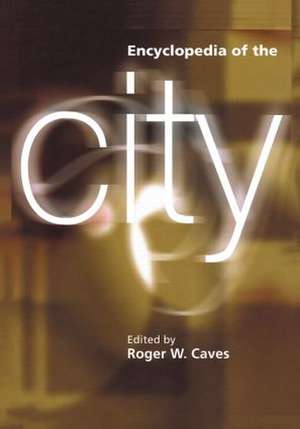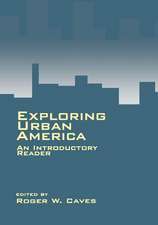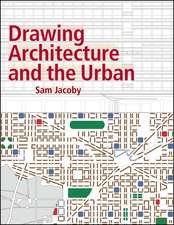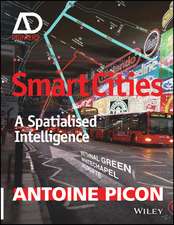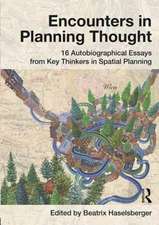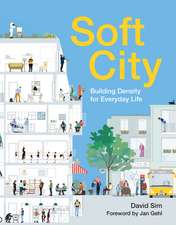Encyclopedia of the City
Editat de Roger W. Cavesen Limba Engleză Paperback – 16 dec 2013
A solid but also provocative starting point for wider exploration of the city, this is a first-class work of reference that will be an essential resource for independent study as well as a useful aid in teaching.
| Toate formatele și edițiile | Preț | Express |
|---|---|---|
| Paperback (1) | 500.15 lei 43-57 zile | |
| Taylor & Francis – 16 dec 2013 | 500.15 lei 43-57 zile | |
| Hardback (1) | 1627.35 lei 43-57 zile | |
| Taylor & Francis – 19 mai 2005 | 1627.35 lei 43-57 zile |
Preț: 500.15 lei
Nou
Puncte Express: 750
Preț estimativ în valută:
95.70€ • 100.18$ • 79.66£
95.70€ • 100.18$ • 79.66£
Carte tipărită la comandă
Livrare economică 31 martie-14 aprilie
Preluare comenzi: 021 569.72.76
Specificații
ISBN-13: 9780415862875
ISBN-10: 0415862876
Pagini: 594
Dimensiuni: 189 x 246 x 31 mm
Greutate: 1.18 kg
Ediția:1
Editura: Taylor & Francis
Colecția Routledge
Locul publicării:Oxford, United Kingdom
ISBN-10: 0415862876
Pagini: 594
Dimensiuni: 189 x 246 x 31 mm
Greutate: 1.18 kg
Ediția:1
Editura: Taylor & Francis
Colecția Routledge
Locul publicării:Oxford, United Kingdom
Notă biografică
Dr. Roger W. Caves is a Professor of City Planning and Director of the Graduate Program in City Planning at San Diego State University, San Diego, California. He received his Ph.D in Urban Affairs and Public Policy from the University of Delaware in 1982. He has been on the faculty at San Diego State University since 1983.
Cuprins
Abercrombie, Patrick; Abu-Lughod, Janet; accessible city; Acropolis; Adams, Thomas; adaptive reuse; Addams, Jane; advocacy planning; agora; air rights; Alberti, Leon Battista; Alexander, Christopher; Alinsky, Saul; alley; Alonso, William; alternative dispute resolution (ADR); Altshuler, Alan; annexation; Appleyard, Donald; Architectural Review Board; back-to-the-city movement; Bacon, Edmund; balanced community; Banfield, Edward; Barnett, Jonathan; baroque city; barrio; Barthes, Roland; Bartholomew, Harland; Bauer, Catherine; beaux arts school; Bell, Daniel; Bell, Wendell; benchmarking; Benevolo, Leonardo; Benjamin, Walter; Berry, Brian J.L.; blight; Blumenfeld, Hans; bonus zoning; boosterism; Booth, Charles; borderless society; boss; boulevard; bourgeois; Bourne, Larry; Boyer, M. Christine; Braudel, Fernand; Briggs, Asa; brownfields; Burnham, Daniel; bustee; Calthorpe, Peter; Calvino, Italo; capacity building; capital accumulation; capital facility planning; capitalist city; cartesian city; Castells, Manuel; Categorical Grant Program; central city; central place theory; centralization; Cerda, Ildefonso; Charter of Athens; Chicago School of Sociology; Choay, Francoise; Christaller, Walter; citadel; cities and film; cities and the arts; cities in literature; cities of difference; citistates; citizenship; city; city beautiful movement; City of Ur; city typologies; civil rights movement; civil society; classicism; closed circuit television (cCTV); coastal management; cognitive mapping; co-housing; colonial city; communitas; community; community conflict resolution; community development block grant; Community Development Corporation (CDC); community goal setting; community policing; community power structure; community visioning; community-based financing; commuters; compact development; condominiums; congestion; conurbation; convention centers; cooperative housing; Costa, Lucio; council housing; courtyard; crime; critical coalition; cross-border region; Cullen, Gordon; cultural heritage; cultural identity; culture; cybercity; Dahl, Robert; Davidoff, Paul; de Certeau, Michel; decentralization; defensible space; demography; density; density bonus; dependency theory; desegregation; development agreements; digital divide; digital government; direct democracy; discrimination; disinvestment; Disney environments; dispersion; divided cities; docklands; dot density map; downtown; Doxiades, Constantinos; drugs; Duany, Andres; DuBois, W.E.B.; economic clusters; economic polarization; economic restructuring; economies of scale; eco-villages; ecumenopolis; education and the city; ekistics; eminent domain; empowerment zone; Engels, Friedrich; environment and the city; environmental behavior; environmental design; environmental impact assessment; environmental justice; environmental perception; environmental sociology; envisionment and discovery collaboratory; equity planning; ethnic conflict; ethnic enclaves; ethno-class relations; European square; exactions; exclusionary zoning; exopolis; export base theory; expropriation; externalities; exurbia; facade preservation; fair share housing allocation; favela; feminist theory; festival marketplaces; festivals; filtering process; fiscal impact analysis; fiscal zoning; floor-area-ratio; Ford, George B.; foreign investment; foreign trade zones; Forester, John; fortified cities; Foucault, Michel; Friedmann, John; frostbelt; gangs; Gans, Herbert; garden city; Garnier, Tony; Garreau, Joel; gated communities; gecekondu; Geddes, Patrick; gemeinschaft; gender discrimination; gender equity planning; gendered spaces; general plan; gentrification; Geographic Information Systems (GIS); George, Henry; gesellschaft; ghetto; Giddens, Anthony; global city; glocalization; Good Government Movement; Goodman, Robert; Goto, Shinpei; Gottman, Jean; governance; graffiti; great society; greenbelts; Gropius, Walter; group home; growth machine; growth management; growth poles; Gruen, Victor; HABITAT 96; Hall, Edward T.; Hall, Sir Peter; Harris, Britton; Harris, Chauncy; Harvey, David; Haussmann, Baron Georges-Eugene; Hayden, Dolores; healthy city; heterotopias; high-occupancy vehicle lanes; high-rise housing estates; hinterland; historic city; historic districts; historic preservation; home rule; homelessness; homeowners' association; homophobia; housing discrimination; housing for specific needs; housing markets; housing societies; housing vouchers; Howard, Ebenezer; human capital; human ecology; humane city; Huxtable, Ada Louise; hygeia; image of the city; immigration; imperial cities; inclusionary housing; incrementalism; index of dissimilarity; industrial city; Industrial Revolution; industrialization; infill development; informal sector; informational city; infrastructure; input-output analysis; insurance redlining; intelligent transport systems; internal structure of the city; international expositions/world fairs; Internet; Ishikawa, Eiyo; Jackson, John Brinckerhoff; Jacobs, Allan B.; Jacobs, Jane (nee Butzner); Kahn, Louis; Kelley, Florence; Kent, Thomas J., Jr. (Jack); Koolhaas, Rem; Krier, Leon; Krier, Rob; Kropotkin, Peter; Krumholz, Norman; L'Enfant, Pierre; labor markets; land banking; land speculation; land trusts; land value capture; latch-key kids; Laws of the Indies; Le Corbusier; Lefebvre, Henri; Lewis, Oscar; Liebow, Elliot; linear city; linkage fees; livable city; locally unwanted land use (LULU); Los Angeles School of Urban Studies; luna parks; Lynch, Kevin; Lyotard, Jean-Francois; MacKaye, Benton; main streets; manufacturing city; maquiladoras; Marsh, Benjamin Clark; mass transit; McHarg, Ian; medieval cities; megacity; megalopolis; melting pot; mercantile city; meta-urbanism; metropolitan statistical area; Meyerson, Martin; Mies van der Rohe, Ludwig; migration; model cities; modernism; Mollenkopf, John; mono-centric city; monuments; Morris, William; Moses, Robert; Moynihan, Daniel Patrick; multi-centric cities; multi-functional urban land use; Mumford, Lewis; Nash, John; necropolis; Negroponte, Nicholas; neighborhood; Neighborhood Watch; New Charter of Athens; new economy; New Federalism; new urbanism; noise; Nolen, John; non-profits and urban services; non-sexist city; not in my back yard (NIMBY); nuclear family; Olmsted, Frederick Law, Olmsted, Frederick Law, Jr., and Olmsted, John C.; open space; Park, Robert E.; parks; pedestrian mall; pedestrian pocket; Peirce, Neal; performance measurement; Perry, Clarence Arthur; Pirenne, Henri; place; Planning Commission; Plater-Zyberk, Elizabeth; police power; polis; political economy; polycentric city; popular culture and cities; populism; port city; Portes, Alejandro; post-fordist system of production; postmodernism; post-socialist city; poverty; principles of intelligent urbanism; privatization; progressive planners; property rights; Pruitt-Igoe; psychogeography; public art; public health surveillance; public space; public/private partnerships; quartered city; radiant city; Rapoport, Amos; redevelopment; red-light districts; redlining; regional planning; renaissance city; rent control; restorative justice; ribbon development; Riis, Jacob; riots; Robinson, Charles Mulford; Rossi, Aldo; Rouse, James; Rowe, Colin; Rykwert, Joseph; safe city; Sandercock, Leonie; Sassen, Saskia; satellite towns; science parks; Scott Brown, Denise; Scully, Vincent J.; segregation; sense of community; sense of place; sexually transmitted diseases; Shevky, Eshref; shopping malls; sidewalks; Simkhovitch, Mary Kingsbury; Simmel, Georg; site value taxation; Sitte, Camillo; skid row; slum; Smart Community; smart growth; social area analysis; social capital; social ecology; social housing; social inequality; social justice; social polarization; socialist city; Soleri, Paolo; Soria y Mata, Arturo; Sorkin, Michael; spatial mismatch; spatial planning; sprawl; squatter settlements; stadia; Stein, Clarence; strategic planning; street people; streetcar suburbs; streets; streetscapes; subdivision; suburb; suburbanization; sunbelt; surveillance; susceptability-to-change (STC); sustainable urban development; Sutcliffe, Anthony; SWOT Analysis; Takayama, Eika; Tange, Kenzo; tax abatements; tax increment financing; technoburbs; techno-city; technopoles; telecommuting; tenements; theme places; theory of demographic transition; third world cities; Tiebout Hypothesis; Tiebout, Charles; Toffler, Alvin; tourism; traffic calming; transfer of development rights; transit-oriented development; transportation and the environment; Tugwell, Rexford; Tyrwhitt, Mary Jaqueline; Ullman, Edward; uneven economic development; urban; urban agriculture; urban crisis; urban decline; urban design; urban ecology; urban forestry; urban form; urban growth boundary; urban homesteading; urban identity; urban indices; urban planning; urban primacy; urban regeneration; urban regime theory; urban renaissance; urban restructuring; urban revitalization; urban sociology; urban squalor; urban stress; urban studies; urban underclass; urban village; urbanism; urbanity; urbanization; urban-rural tension; utopia; van Esteren, Cornelius; vandalism; Veiller, Lawrence; Venturi, Robert; vernacular architecture; victory garden; view corridors; visual preferences; Wade, Richard C.; walking city; walled cities; war; war on poverty; Warner Jr., Sam Bass; waterfront development; Webber, Melvin; Weber, Max; welfare to work; white flight; Whyte, William H.; Willmott, Peter; Wilson, William Julius; Wirth, Louis; Woods, Robert Archey; world bank; world city hypothesis; Wren, Sir Christopher; Wright, Frank Lloyd; Young, Michael; zero tolerance; zoning (cCTV); coastal management; cognitive mapping; co-housing; colonial city; communitas; community; community conflict resolution; community development block grant; Community Development Corporation (CDC); community goal setting; community policing; community power structure; community visioning; community-based financing; commuters; compact development; condominiums; congestion; conurbation; convention centers; cooperative housing; Costa, Lucio; council housing; courtyard; crime; critical coalition; cross-border region; Cullen, Gordon; cultural heritage; cultural identity; culture; cybercity; Dahl, Robert; Davidoff, Paul; de Certeau, Michel; decentralization; defensible space; demography; density; density bonus; dependency theory; desegregation; development agreements; digital divide; digital government; direct democracy; discrimination; disinvestment; Disney environments; dispersion; divided cities; docklands; dot density map; downtown; Doxiades, Constantinos; drugs; Duany, Andres; DuBois, W.E.B.; economic clusters; economic polarization; economic restructuring; economies of scale; eco-villages; ecumenopolis; education and the city; ekistics; eminent domain; empowerment zone; Engels, Friedrich; environment and the city; environmental behavior; environmental design; environmental impact assessment; environmental justice; environmental perception; environmental sociology; envisionment and discovery collaboratory; equity planning; ethnic conflict; ethnic enclaves; ethno-class relations; European square; exactions; exclusionary zoning; exopolis; export base theory; expropriation; externalities; exurbia; facade preservation; fair share housing allocation; favela; feminist theory; festival marketplaces; festivals; filtering process; fiscal impact analysis; fiscal zoning; floor-area-ratio; Ford, George B.; foreign investment; foreign trade zones; Forester, John; fortified cities; Foucault, Michel; Friedmann, John; frostbelt; gangs; Gans, Herbert; garden city; Garnier, Tony; Garreau, Joel; gated communities; gecekondu; Geddes, Patrick; gemeinschaft; gender discrimination; gender equity planning; gendered spaces; general plan; gentrification; Geographic Information Systems (GIS); George, Henry; gesellschaft; ghetto; Giddens, Anthony; global city; glocalization; Good Government Movement; Goodman, Robert; Goto, Shinpei; Gottman, Jean; governance; graffiti; great society; greenbelts; Gropius, Walter; group home; growth machine; growth management; growth poles; Gruen, Victor; HABITAT 96; Hall, Edward T.; Hall, Sir Peter; Harris, Britton; Harris, Chauncy; Harvey, David; Haussmann, Baron Georges-Eugene; Hayden, Dolores; healthy city; heterotopias; high-occupancy vehicle lanes; high-rise housing estates; hinterland; historic city; historic districts; historic preservation; home rule; homelessness; homeowners' association; homophobia; housing discrimination; housing for specific needs; housing markets; housing societies; housing vouchers; Howard, Ebenezer; human capital; human ecology; humane city; Huxtable, Ada Louise; hygeia; image of the city; immigration; imperial cities; inclusionary housing; incrementalism; index of dissimilarity; industrial city; Industrial Revolution; industrialization; infill development; informal sector; informational city; infrastructure; input-output analysis; insurance redlining; intelligent transport systems; internal structure of the city; international expositions/world fairs; Internet; Ishikawa, Eiyo; Jackson, John Brinckerhoff; Jacobs, Allan B.; Jacobs, Jane (nee Butzner); Kahn, Louis; Kelley, Florence; Kent, Thomas J., Jr. (Jack); Koolhaas, Rem; Krier, Leon; Krier, Rob; Kropotkin, Peter; Krumholz, Norman; L'Enfant, Pierre; labor markets; land banking; land speculation; land trusts; land value capture; latch-key kids; Laws of the Indies; Le Corbusier; Lefebvre, Henri; Lewis, Oscar; Liebow, Elliot; linear city; linkage fees; livable city; locally unwanted land use (LULU); Los Angeles School of Urban Studies; luna parks; Lynch, Kevin; Lyotard, Jean-Francois; MacKaye, Benton; main streets; manufacturing city; maquiladoras; Marsh, Benjamin Clark; mass transit; McHarg, Ian; medieval cities; megacity; megalopolis; melting pot; mercantile city; meta-urbanism; metropolitan statistical area; Meyerson, Martin; Mies van der Rohe, Ludwig; migration; model cities; modernism; Mollenkopf, John; mono-centric city; monuments; Morris, William; Moses, Robert; Moynihan, Daniel Patrick; multi-centric cities; multi-functional urban land use; Mumford, Lewis; Nash, John; necropolis; Negroponte, Nicholas; neighborhood; Neighborhood Watch; New Charter of Athens; new economy; New Federalism; new urbanism; noise; Nolen, John; non-profits and urban services; non-sexist city; not in my back yard (NIMBY); nuclear family; Olmsted, Frederick Law, Olmsted, Frederick Law, Jr., and Olmsted, John C.; open space; Park, Robert E.; parks; pedestrian mall; pedestrian pocket; Peirce, Neal; performance measurement; Perry, Clarence Arthur; Pirenne, Henri; place; Planning Commission; Plater-Zyberk, Elizabeth; police power; polis; political economy; polycentric city; popular culture and cities; populism; port city; Portes, Alejandro; post-fordist system of production; postmodernism; post-socialist city; poverty; principles of intelligent urbanism; privatization; progressive planners; property rights; Pruitt-Igoe; psychogeography; public art; public health surveillance; public space; public/private partnerships; quartered city; radiant city; Rapoport, Amos; redevelopment; red-light districts; redlining; regional planning; renaissance city; rent control; restorative justice; ribbon development; Riis, Jacob; riots; Robinson, Charles Mulford; Rossi, Aldo; Rouse, James; Rowe, Colin; Rykwert, Joseph; safe city; Sandercock, Leonie; Sassen, Saskia; satellite towns; science parks; Scott Brown, Denise; Scully, Vincent J.; segregation; sense of community; sense of place; sexually transmitted diseases; Shevky, Eshref; shopping malls; sidewalks; Simkhovitch, Mary Kingsbury; Simmel, Georg; site value taxation; Sitte, Camillo; skid row; slum; Smart Community; smart growth; social area analysis; social capital; social ecology; social housing; social inequality; social justice; social polarization; socialist city; Soleri, Paolo; Soria y Mata, Arturo; Sorkin, Michael; spatial mismatch; spatial planning; sprawl; squatter settlements; stadia; Stein, Clarence; strategic planning; street people; streetcar suburbs; streets; streetscapes; subdivision; suburb; suburbanization; sunbelt; surveillance; susceptability-to-change (STC); sustainable urban development; Sutcliffe, Anthony; SWOT Analysis; Takayama, Eika; Tange, Kenzo; tax abatements; tax increment financing; technoburbs; techno-city; technopoles; telecommuting; tenements; theme places; theory of demographic transition; third world cities; Tiebout Hypothesis; Tiebout, Charles; Toffler, Alvin; tourism; traffic calming; transfer of development rights; transit-oriented development; transportation and the environment; Tugwell, Rexford; Tyrwhitt, Mary Jaqueline; Ullman, Edward; uneven economic development; urban; urban agriculture; urban crisis; urban decline; urban design; urban ecology; urban forestry; urban form; urban growth boundary; urban homesteading; urban identity; urban indices; urban planning; urban primacy; urban regeneration; urban regime theory; urban renaissance; urban restructuring; urban revitalization; urban sociology; urban squalor; urban stress; urban studies; urban underclass; urban village; urbanism; urbanity; urbanization; urban-rural tension; utopia; van Esteren, Cornelius; vandalism; Veiller, Lawrence; Venturi, Robert; vernacular architecture; victory garden; view corridors; visual preferences; Wade, Richard C.; walking city; walled cities; war; war on poverty; Warner Jr., Sam Bass; waterfront development; Webber, Melvin; Weber, Max; welfare to work; white flight; Whyte, William H.; Willmott, Peter; Wilson, William Julius; Wirth, Louis; Woods, Robert Archey; world bank; world city hypothesis; Wren, Sir Christopher; Wright, Frank Lloyd; Young, Michael; zero tolerance; zoning
Descriere
A first-class work of reference that will be both an essential resource for independent study as well as a useful aid in teaching: a solid but also provocative starting point for wider exploration of the city.
